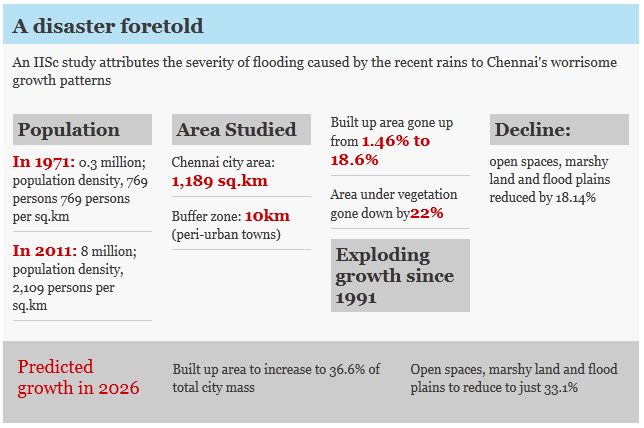Chennai’s resilience to the recent deluge has taken a severe beating as nearly a quarter of its wetlands, open space and flood plains have given way to concrete structures.
Months before the series of depressions and “freak” weather developments hit the city, researchers at the Centre for Ecological Sciences in the Indian Institute of Science (IISc), Bengaluru, tabulated the “worrisome” growth patterns of the coastal city.
The research, which is to be published in the Journal of the Indian Society of Remote Sensing, shows that since 1991, the city’s concrete structures have increased nearly 13 times. Correspondingly, flood plains and open areas have been reduced by a fourth.
The results were tabulated through a combination of satellite imagery, which was then superimposed over topological maps of the Survey of India as well as from the Chennai municipality.

Unplanned growth
Satellite images and predictive modelling show that the northwest and southwest zones of Chennai are seeing the most unplanned growth — an observation that correlates with not only the levelling of marshlands, but also the areas worst affected by the recent floods.
Growth outlook
The outlook, predicted through the modelling of current growth along with planned and unplanned expansion of the city, looks grim. Built-up area of asphalt, concrete and metal is set to nearly double in size over the next decade, while open spaces will decline by a third.
Significant changes can be seen in areas which fall within the CMDA [Chennai Metropolitan Development Authority] boundary such as the Korattur and Cholavaram lake bed, the Red Hills catchment area, the Perungalathur forest area, and the Sholinganallur wetland area.
The metro tops the list in emissions
While bad planning and destruction of marshy lands may have only exasperated the devastation of the floods, IISc researcher T.V. Ramachandra is quick to point out that along with other major metros, Chennai must address its greenhouse emissions that contribute to climate change.
His recent research on carbon footprints in major metros of the country shows that Chennai tops the list in emissions per capita.
The city releases nearly 4.79 tones of CO2 per person per year, while Kolkata comes a distant second at 3.29 tonnes per capita. The highest contributor is industrial emission, where 4.4 million tonnes of CO2 in the year studied.
Source: The Hindu
Current Affairs: 12th December, 2015 Current Affairs: 11th December, 2015 Current Affairs bullet points Round up 1st to 6th December, 2015 Current Affairs Round up November, 2015.

Join The Discussion